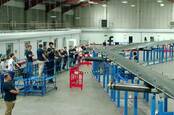This article is more than 1 year old
Alphabet's internet Loon balloon kept on station in the sky using AI that beat human-developed control code
Maybe this might work after all
Loon, known for its giant billowing broadband-beaming balloons, says it has figured out how to use machine-learning algorithms to keep its lofty vehicles hovering in place autonomously in the stratosphere.
The 15-metre-wide balloons relay internet connections between people's homes and ground stations that could be thousands of kilometres apart. To form a steady network that can route data over long distances reliably, the balloons have to stay in place, and do so all by themselves.
Loon's AI-based solution to this station-keeping problem has been described in a research paper published in Nature on Wednesday, and basically it works by adjusting the balloons' altitude to catch the right wind currents to ensure they are where they need to be.
The machine-learning software, we're told, managed to successfully keep the Loon gas bags bobbing up and down in the skies above in the Pacific Ocean in an experiment that lasted 39 days. Previously, the Loon team used a non-AI controller that used a handcrafted algorithm known as StationSeeker to do the job, though decided to experiment to see whether it could find a more efficient method using machine learning.
"As far as we know, this is the world's first deployment of reinforcement learning in a production aerospace system," said Loon CTO Salvatore Candido.
The AI is built out of a feed-forward neural network that learns to decide whether a balloon should fly up or go down by taking into account variables, such as wind speed, solar elevation, and how much power the equipment has left. The decision is then fed to a controller system to move the balloon in place.
By training the model in simulation, the neural network steadily improved over time using reinforcement learning as it repeated the same task over and over again under different scenarios. Loon tested the performance of StationSeeker against the reinforcement learning model in simulation.
"A trial consists of two simulated days of station-keeping at a fixed location, during which controllers receive inputs and emit commands at 3-min intervals," according to the paper. The performance was then judged by how long the balloons could stay within a 50km radius of a hypothetical ground station.
The AI algorithm scored 55.1 per cent efficiency, compared to 40.5 per cent for StationSeeker. The researchers reckon that the autonomous algorithm is near optimum performance, considering that the best theoretical models reach somewhere between 56.8 to 68.7 per cent.
When Loon and Google ran the controller in the real experiment, which involved a balloon hovering above the Pacific Ocean, they found: "Overall, the [reinforcement learning] system kept balloons in range of the desired location more often while using less power... Using less power to steer the balloon means more power is available to connect people to the internet, information, and other people."
The balloon carries a payload of about 100kg, taking with it various electronics to collect solar energy, and communications equipment. Flying a balloon to a specific location is a different problem altogether.
"A fleet dispatch system assigns each balloon to a particular location, and a navigation controller brings it in the vicinity of that location before switching control to the station-keeping controller," the paper explained.
Loon will continue testing its balloons to provide wireless broadband service to areas that lack traditional fiber optic cables. It has sent one to Kenya and plans to send another to South America over the Amazon Rainforest. ®

